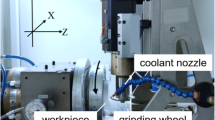Abstract
Grinding is the main process step for the high-precision optical components, and its process parameters may bring forth subsurface damage to some degrees on the surfaces and finally result in the variation of the mechanical and optical properties of the components. In this paper, the ground sample is etched to expose the micro cracks and the characterization parameters of the subsurface damage are extracted using the image processing method. To investigate the influence of main grinding parameters on the micro cracks of subsurface damage, relationships among the average abrasive size, grinding force, wheel speed, and grinding depth and characterization parameters (length, angle, and density) of micro cracks are established. The results show that the influence of grinding parameters on the micro crack’s length is consistent with that on the surface roughness. The average abrasive size and grinding force have obvious influence on the subsurface damage and surface roughness than wheel speed and grinding depth. Micro cracks’ angle and density are almost not affected by the grinding parameters.
Similar content being viewed by others
References
Fähnle OW, van Brug HH (1999) Novel approaches to generate aspherical optical surfaces. Int Soc Opt Photon 3782:170–180
Wang J, Li YG, Han JH, Xu Q, Guo YB (2011) Evaluating subsurface damage in optical glasses. J Eur Opt Soc – Rapid Publications 6:11001
Lawn B (1993) Fracture of brittle solids. Cambridge University Press, Cambridge
Lawn B, Wilshaw R (1975) Indentation fracture: principle and applications. J Mater Sci 10(6):1049–1081
Conway JC, Kirchner HP (1986) Crack branching as a mechanism of crushing during grinding. J Am Ceram Soc 69:603–607
Malkin S, Ritter JE (1989) Grinding mechanisms and strength degradation for ceramics. J Eng Ind 111(2):167–174
Zhang B, Zheng XL, Tokura H, Yoshikawa M (2003) Grinding induced damage in ceramics. J Mater Process Technol 132(1–3):353–364
Exarhos GJ, Miller PE, Suratwala TI, Wong LL, Feit MD, Menapace JA, Davis PJ, Steele RA (2005) The distribution of subsurface damage in fused silica. Laser-induced Damage Opt Mater 5991:01–25
Suratwala T, Wong L, Miller P, Feit MD, Menapace J, Steele R, Davis P, Walmer D (2006) Sub-surface mechanical damage distributions during grinding of fused silica. J Non-Cryst Solids 352:5601–5617
Chen JB, Fang QH, Li P (2015) Effect of grinding wheel spindle vibration on surface roughness and subsurface damage in brittle material. Int J Mach Tools Manuf Grinding 91:12–23
Esmaeilzare A, Rahimi A, Rezaei SM (2014) Investigation of subsurface damages and surface roughness in grinding process of Zerodur glass-ceramic. J Appl Surf Sci 313:67–75
Sanjay A, Venkateswara PR (2008) Experimental investigation of surface/subsurface damage formation and material removal mechanisms in SiC grinding. Int J Mach Tools Manuf 48:698–710
Chen MJ, Zhao QL, Dong S, Dan L (2005) The critical conditions of brittle–ductile transition and the factors influencing the surface quality of brittle materials in ultra-precision grinding. J Mater Process Technol 168(1-15):75–82
Gopal AV, Venkateswara Rao P (2003) Selection of optimum conditions for maximum material removal rate with surface finish and damage as constraints in SiC grinding. Int J Mach Tools Manuf 43(13):1327–1336
Yao ZQ, Gu WB, Li KM (2012) Relationship between surface roughness and subsurface crack depth during grinding of optical glass BK7. J Mater Process Technol 212(4):969–976
Ahn Y, Cho N, Lee S, Lee D (2003) Lateral crack in abrasive wear of brittle materials. JSME Int J Ser A 46:140–144
Li YG, Zheng N, Li HB, Hou J, Lei XY, Chen XH, Yuan ZG, Guo ZZ, Wang J, Guo YB, Xu Q (2011) Morphology and distribution of subsurface damage in optical fused silica parts: bound-abrasive grinding. Appl Surf Sci 257:2066–2073
Lv DX, Huang YH, Tang YJ, Wang HX (2012) Relationship between subsurface damage and surface roughness of glass BK7 in rotary ultrasonic machining and conventional grinding processed. Int J Adv Manuf Technol 67:613–622
Wei SL, Zhao H, Jing JT, Liu YF (2015). Investigation on surface micro-crack evaluation of engineering ceramics by rotary ultrasonic grinding machining. Int J Adv Manuf Technol 1:1–10
Steele R (2009) The effect of HF/NH4F etching on the morphology of surface fractures on fused silica. J Non-Cryst Solids 355:797–810
Wang HR, Chen HF, Xiao LH, Zhang BK, Jiang ZD (2015) Fast prediction statistical subsurface damage parameters of the K9 sample. Int J Optomechatronics 197–201
Li S, Wang Z, Wu Y (2008) Relationship between subsurface damage and surface roughness of optical materials in grinding and lapping processes. J Mater Process Technol 205:34–41
Author information
Authors and Affiliations
Corresponding author
Rights and permissions
About this article
Cite this article
Wang, H., Chen, H., Fu, G. et al. Relationship between grinding process and the parameters of subsurface damage based on the image processing. Int J Adv Manuf Technol 83, 1707–1715 (2016). https://doi.org/10.1007/s00170-015-7691-0
Received:
Accepted:
Published:
Issue Date:
DOI: https://doi.org/10.1007/s00170-015-7691-0



